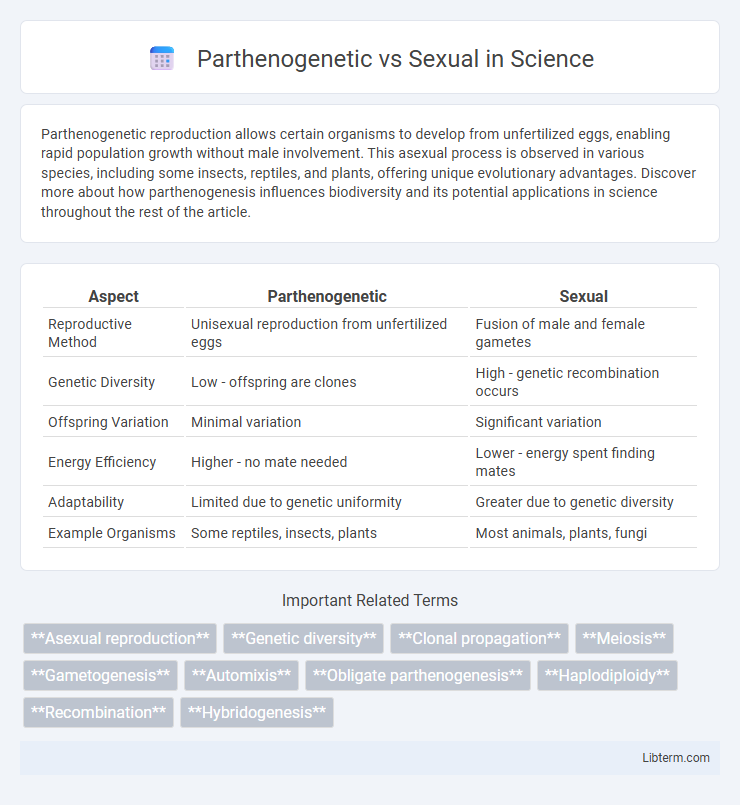Parthenogenetic reproduction allows certain organisms to develop from unfertilized eggs, enabling rapid population growth without male involvement. This asexual process is observed in various species, including some insects, reptiles, and plants, offering unique evolutionary advantages. Discover more about how parthenogenesis influences biodiversity and its potential applications in science throughout the rest of the article.
Table of Comparison
| Aspect | Parthenogenetic | Sexual |
|---|---|---|
| Reproductive Method | Unisexual reproduction from unfertilized eggs | Fusion of male and female gametes |
| Genetic Diversity | Low - offspring are clones | High - genetic recombination occurs |
| Offspring Variation | Minimal variation | Significant variation |
| Energy Efficiency | Higher - no mate needed | Lower - energy spent finding mates |
| Adaptability | Limited due to genetic uniformity | Greater due to genetic diversity |
| Example Organisms | Some reptiles, insects, plants | Most animals, plants, fungi |
Introduction to Parthenogenetic and Sexual Reproduction
Parthenogenetic reproduction involves females producing offspring without fertilization, resulting in clones genetically identical to the mother, commonly observed in some reptiles, insects, and plants. Sexual reproduction entails the combination of genetic material from two parents, producing genetically diverse offspring through the fusion of male and female gametes. This genetic variation enhances adaptability and survival in changing environments, contrasting the uniformity of parthenogenetic populations.
Defining Parthenogenesis: Key Concepts
Parthenogenesis is a form of asexual reproduction where offspring develop from unfertilized eggs, eliminating the need for male gametes. This reproductive strategy enables certain species, such as some reptiles, amphibians, and invertebrates, to reproduce rapidly while maintaining genetic consistency. Unlike sexual reproduction, which involves genetic recombination from two parents, parthenogenesis results in clones or near-identical genetic copies, influencing evolutionary adaptation and population dynamics.
Overview of Sexual Reproduction Mechanisms
Sexual reproduction involves the fusion of haploid gametes from two parents, resulting in genetically diverse offspring through meiosis and fertilization processes. Key mechanisms include chromosomal crossover during meiosis, which increases genetic variation, and the production of specialized reproductive cells--sperm and eggs--that combine to form a diploid zygote. This genetic recombination and offspring diversity enhance adaptability and evolution within populations.
Evolutionary Origins of Both Reproductive Strategies
Parthenogenetic reproduction, arising independently in multiple lineages, offers rapid population growth and colonization advantages by bypassing fertilization, with evidence suggesting origins in response to stable environments or mate scarcity. Sexual reproduction, rooted in the early evolution of eukaryotes over a billion years ago, enhances genetic diversity through recombination, facilitating adaptation to changing environments and parasite pressures. The evolutionary divergence reflects a balance between the short-term efficiency of parthenogenesis and the long-term adaptive benefits conferred by sexual reproduction.
Genetic Diversity: Parthenogenetic vs Sexual Offspring
Parthenogenetic offspring arise from a single parent without genetic recombination, resulting in low genetic diversity and uniform populations. Sexual reproduction combines genetic material from two parents, producing offspring with high genetic variability, which enhances adaptability and survival in changing environments. This genetic diversity is crucial for evolving resistance to diseases and environmental stressors.
Ecological Advantages and Disadvantages
Parthenogenetic reproduction allows rapid population growth and colonization in stable environments by producing genetically identical offspring without the need for mates, enhancing survival in isolated or consistent habitats. Sexual reproduction generates genetic diversity through recombination, increasing adaptability to changing environments and resistance to diseases or parasites. While parthenogenesis may limit evolutionary potential due to low genetic variation, sexual reproduction incurs higher energy costs and slower population increase due to mate-finding and offspring development constraints.
Examples of Parthenogenetic and Sexual Species
Parthenogenetic species include the whiptail lizard (Aspidoscelis uniparens) and the aphid, which reproduce without fertilization, enabling rapid population growth in stable environments. Sexual reproduction, characterized by the combination of genetic material from two parents, occurs in species such as humans (Homo sapiens) and fruit flies (Drosophila melanogaster), promoting genetic diversity and adaptation. These reproductive strategies illustrate distinct evolutionary advantages, with parthenogenesis favoring speed and efficiency, while sexual reproduction enhances variability and resilience.
Environmental Influences on Reproductive Strategy
Environmental factors significantly influence reproductive strategies, with parthenogenetic organisms often thriving in stable, resource-rich habitats where rapid population growth is advantageous. Sexual reproduction is favored in variable or unpredictable environments, promoting genetic diversity that enhances adaptability and survival under changing conditions. Temperature, resource availability, and predation pressure are key environmental drivers determining the prevalence of parthenogenetic versus sexual reproduction.
Implications for Survival and Adaptability
Parthenogenetic reproduction allows rapid population growth and colonization in stable environments by producing genetically identical offspring, but it limits genetic diversity and adaptability to changing conditions. Sexual reproduction enhances genetic variation through recombination, increasing the potential for populations to adapt to environmental fluctuations and resist diseases. This genetic diversity conferred by sexual reproduction often improves long-term survival and evolutionary resilience.
Future Perspectives in Reproductive Biology
Future perspectives in reproductive biology emphasize advancing techniques to manipulate parthenogenetic and sexual reproduction for improving fertility and genetic diversity. Innovations in CRISPR gene editing and stem cell research may enable precise control over embryonic development, enhancing outcomes in parthenogenetic embryo viability and sexual reproduction efficiency. Understanding epigenetic regulation and molecular signaling pathways will be crucial for developing sustainable reproductive technologies in agriculture, medicine, and biodiversity conservation.
Parthenogenetic Infographic

 libterm.com
libterm.com